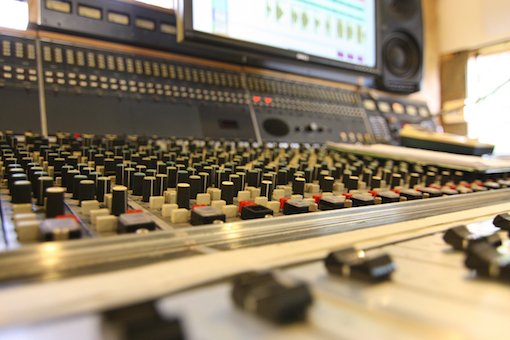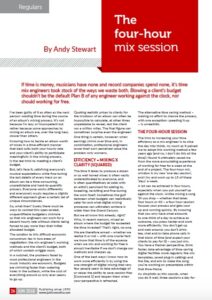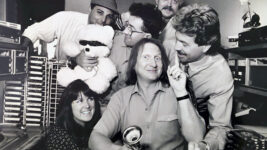Subscribe to CX E-News
Regulars
By Andy Stewart.
If time is money, musicians have none and record companies spend none, it’s time mix engineers took stock of the ways we waste both. Blowing a client’s budget shouldn’t be the default Plan B of any engineer working against the clock, nor should working for free.
I’ve been guilty of it as often as the next person: wasting time during the course of an album’s mixing process. It’s not because I’m lazy or incompetent but rather because some approaches to mixing an album are, over the long haul, slower than others.
Knowing how to tackle an album worth of mixes in a time-efficient manner that best suits both your hourly rate and your client’s ability to participate meaningfully in the mixing process, is the real trick to meeting a client’s budget.
But, let’s face it, satisfying everyone’s musical expectations while fine-tuning the last details of every track on an album can be a time-consuming, unpredictable and hard-to-quantify process. Everyone works differently and everyone’s music requires a slightly different approach given a certain set of unique circumstances.
So, what then? Surely there must be ways to combat this open-ended, unquantifiable budgetary sinkhole so that mix engineers can work for a decent hourly rate without clients being forced to pay more than their initial allocated budget.
The solution to this difficult economic conundrum lies in two areas of negotiation: the mix engineer’s working methods and the client’s budget, both of which contain wriggle room.
In a nutshell, the problems faced by most professional engineers in the music industry are economic. Budgets are shrinking faster than watering holes in the outback, while the cost of everything around us only ever seems to go up.
Quoting realistic prices to clients for the mixdown of an album can often be impossible to calculate, at other times unpalatable to reveal, lest the client run a million miles. The final figure can sometimes surprise even the engineer! One thing is certain, however: when earnings shrink over time and, in combination, professional engineers lower their own perceived value the problem only worsens.
EFFICIENCY = MIXING X CLARITY (SQUARED)
The time it takes to produce a dozen or so well honed mixes is often vastly underestimated by everyone, and is often quantitatively at odds with an artist’s penchant for adding to, tweaking, revisiting and fine-tuning the work itself.
Sometimes the gulf between what budgets can realistically cater for and what digital mixing processes can ultimately achieve is wider than the Grand Canyon. But we all know this already, right? Who, in recent memory, mixed an album where the budget far exceeded the time invested? That’s right, no-one.
We are therefore armed – whether we realise it or not – with one crucial fact: we know that time is of the essence when we mix and working for free is almost inevitable if we don’t change our methods and sharpen up.
One of the best ways I know how to work more efficiently is by using the one strength of digital mixing that very few people seem to take advantage of or value: the ability to save session files [Command S] and reopen them when your perspective is refreshed.
The alternative time saving method – making no effort to chance the process, with one exception: speeding it up – is unrealistic.
THE FOUR-HOUR SESSION
The trick to increasing your time efficiency as a mix engineer is to slice the day into thirds. As much as it pained me to adopt this working method a few years ago (and no, I don’t do this all the time) I found it ultimately saved me from the more excruciating experience of working for free for a week at the end of a project.
The four-hour mix window is my new ‘one day session’, and I try and work up to 15 of these ‘days’ a week.
A lot can be achieved in four hours, especially when you put yourself up against the clock. Unlike mixing a song ’til you drop – whether that takes four hours or 40 – a four hour session focuses your process and gets your up and running quickly.
By knowing that you only have what amounts to one-third of a day to achieve an outcome, you press harder and work more efficiently. You don’t get up and walk around, you don’t drink tea, chat and/or take phone calls in that block of time (and expect your clients to pay for it) – you just mix.
You have a fresher perspective, think faster, take advantage of time-saving digital facilities more regularly like mix templates, saved plug-in settings and the like, and aim to make the song you’re working on presentable within that time-frame.
As simplistic as this sounds, when you do it well, three sessions a day for a week, at the end of that time you basically have an album in the can.
Of course, you might then spend another week expanding upon these mixes: exploring their dynamic shifts, fine tuning various details and adding new production effects. But by working in smaller time chucks you get further down the road faster, to a point where the discussion with your client becomes more about detail than broad strokes.
As stated in a previous CX article a few years ago – and it’s arguably truer today than ever – as a general rule, any time spent in front of a piece of music should involve some sort of productive work.Don’t just have it playing over and over in the background while you have dinner.
When you’re hearing it, it should count.
There’s no point rushing things, but neither should mix sessions (professional or otherwise) dawdle along at a snail’s pace as if time is somehow irrelevant to the outcome. It’s always relevant, irrespective of the budget.
ATTACK OF THE ACCOUNTANTS
The other side of this coin is, of course, budget. As I’ve said repeatedly in articles before, there’s no point starting a mix project without some sort of budgetary discussion and agreement around terms.
Clarity at the beginning of a mix project is crucial to friendly and balanced interactions throughout, so do yourself a favour at the outset and get a budget on paper that lists what you expect to achieve in what timeframe, and for how much.
Prior to this, do a rough calculation of how much it has cost your clients to work with you in the past, per song. If determining that all seems impossible, think again. Simply work out how much you’ve earned from mixing in the last 12 months and divide that figure by how many songs you’ve mixed in that same period.
If the figure seems low, well then congratulations, you’ve been selling yourself short. Alternatively, if it’s reasonable then quote a figure that’s roughly based on that. Most people who, when pressed, don’t know how to quote have never done this most basic calculation.
The trick to getting people on board with a realistic budget – especially when it starts off painfully low – is to detail what’s involved in the project in a friendly discussion at the outset. Far more than your clients in most cases, you know the nitty gritty of what’s involved in the process – you might have done 100 albums, or 1000, they may have done two – so pointing out the oversights in their rough mental arithmetic can often see the budget increase to a more realistic figure.
A SHORT NOTE ON GOING IT ALONE
Sometimes mixing without clients is unavoidable, but often it’s a short route to working long hours without pay. Why? Because often what you mix in a client’s absence isn’t quite what they’d hoped for, and getting the mixes realigned with their expectations can sometimes be a time sink of hellish proportions.
And who will pay for this realignment in most cases? Depending on your definition of the word ‘pay’ either no-one, or you. It won’t be the client.
I know it may seem preferable – and faster in some circumstances – to mix without a client present, but often it’s not. Generally speaking, having the client in a session is your greatest asset and a means to quick outcomes, provided you know how to interact with them and ask the right questions.
When the budget’s tight and working on a project seems to makes no financial sense, push for more funds and work faster (not less effectively) by cutting your days into thirds. Four-hour sessions might just be the answer to that problem we all face – working for nix!
Andy Stewart owns and operates The Mill in the hills of Bass Coast in Victoria. He’s happy to respond to any pleas for recording or mixing help… contact him at: andy@themillstudio.com.au
This article first appeared in the print edition of CX Magazine June 2018, pp.26-27. CX Magazine is Australia and New Zealand’s only publication dedicated to entertainment technology news and issues. Read all editions for free or search our archive www.cxnetwork.com.au
© CX Media
Lead image – The Mill’s Neve close up
Subscribe
Published monthly since 1991, our famous AV industry magazine is free for download or pay for print. Subscribers also receive CX News, our free weekly email with the latest industry news and jobs.













